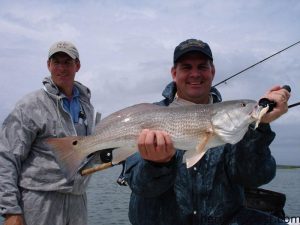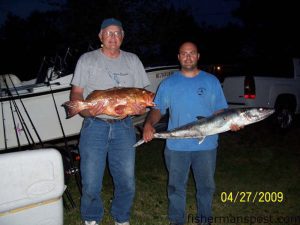Swansboro May 21, 2009

Brothers Win and Dave Edwards, from Kinston, NC, with one of many red drum they caught on spinning and fly tackle while fishing near Swansboro with Capt. Jeff Cronk of FishN4LIfe Charters.
Jeff, of FishN4Life Charters, reports that higher tides, especially rising tides in the mornings and evenings, will present anglers with some good redfishing opportunities this week. Scattered schools of reds (most 16-24″, with a few larger fish) are feeding along flooded grass edges on the rising tides and channel drop-offs and oyster rocks on the fall. Topwater plugs, spinnerbaits, soft jerkbaits, and Gulp shrimp under popping corks will all produce results on the reds. Anglers have also been hooking up with some drum on the fly while casting orange and copper Clouser Minnows.
Black drum (most 1-5 lbs.) are feeding alongside the reds in some places, and anglers can target them with fresh shrimp or small Gulp shrimp under popping corks. Live shrimp should become more plentiful over the next few weeks, and they are the best baits for the black drum.
Summer flounder are moving from the ocean into the inlets and sounds. Drifting with live finger mullet, peanut pogies, or mud minnows will produce action with the flatties. The larger flounder can be found close to structure like channel walls, dock pilings, or rocky bulkheads, and fishing around the tide changes will allow anglers to get baits into areas where the current is ordinarily too strong.
Outside the inlets, the spanish mackerel, king mackerel, and cobia have shown up.
Spanish (most 1-4 lbs.) are feeding around the nearshore AR’s, along the inlet tide lines, and running the beaches. They’ll take an interest in trolled spoons and diving plugs or small live baits.
The kings are a bit further offshore, but they should be making their way to the beaches later in the week. Live baits are top choices for the kings, but they’ll also bite diving plugs or dead baits.
The cobia have shown up around the inlets, and anglers can target them through May and into June. Slow trolling live pogies on a 6/0 to 8/0 circle hook is the best method, and getting the bait down with a 3-6 oz. egg sinker or on a downrigger will produce the most action. Trolling near the inlet tide lines, nearshore rocks and AR’s, and buoys will give anglers their best shot at a cobia.

Bob Sheperd, from Kingsport, TN, and Andrew Sheperd, from Wilmington, with a red grouper and a king mackerel they caught near 23 Mile Rock in 90' of water. The red fell for a live pinfish on the bottom, and the king attacked a vertical jig.
Rob, of Sandbar Safari Charters, reports that the cobia bite was excellent around Beaufort Inlet last week, and it should remain good when southwest winds continue to push fish towards the inlets. Fishing with live pogies around Beaufort Inlet has produced cobia (up to 63 lbs.) lately, and there should be some fish around Bogue Inlet as well. Higher rising tides create good fishing conditions just inside the inlets, while fishing outside is better on falling tides.
Chopper bluefish (5-10 lbs.) are feeding around the inlets as well, and anglers can hook plenty by trolling Yo-Zuri Deep Divers (with pink, chartreuse, and white particularly good). Once the fish are located, casting lures will draw strikes, and anglers may be able to coax them into explosive strikes on topwaters as well.
Spanish mackerel are showing up inside the inlets, with most of the fish keepers. The fish can be found chasing bait in the inlet channels and ICW, and trolled Clarkspoons will attract their attention. Larger spanish are feeding just off the beaches in 30-40′ of water.
Inshore, the red drum bite is getting good in the marshes behind the barrier islands, but anglers still have to do some looking to find the pods of fish. Topwater plugs have been effective on the reds lately, and if anglers miss a fish on top, casting back to the area with a Gulp shrimp should provoke the fish to bite.
Flounder are moving into the inlets, and they will take an interest in live finger mullet or other baits fished on Carolina rigs.
Black drum and sheepshead are beginning to show up in the area, and the bite is usually excellent when the fish first arrive. Fishing fiddler or mud crabs near hard structure like oyster rocks and bridge pilings will produce action with both fish. Fresh shrimp will also strike the black drum’s fancy.
Stan, of Capt. Stanman’s Charters, reports that boats trolling the Gulf Stream are finding some wahoo and good numbers of dolphin, but few yellowfin or blackfin tunas.
Trolling from the 90′ Drop to the Big Rock and then down towards the Rise and Swansboro Hole will help anglers locate the fish, and skirted ballyhoo or lures like Yo-Zuri Deep Divers will draw strikes.
Butterfly jigging in 50-60 fathoms has been effective on a variety of groupers and tilefish lately.
Inshore of the break, the bottom bite has been good in 100’+, with anglers hooking grouper, sea bass, triggerfish, beeliners, and other bottom dwellers.
Rhonda, of Bogue Inlet Pier, reports that plug casters are finding action with bluefish and spanish mackerel on Gotchas when the water’s clean.
Cut baits are also producing bites from the blues (including some choppers).
Bottom fishermen are catching a few whiting on shrimp.
The water is 71 degrees.
